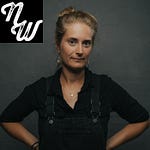Juan Sebastián Pérez is the owner of the restaurant Quitu in Quito, Ecuador. I was there for the first time earlier in the year and what I liked the most about it was that it felt like Quito, at least to me. There are a lot of ambitious restaurants in Latin America, that feel like they could be anywhere. Like they equate quality by looking international. At Quitu – the wood tables, the walls, the woven light fixtures, the kind of rooms of various shapes and sizes – it feels like Ecuador, and it made for a far more interesting experience. To me, at least.
The restaurant is now in its fourth incarnation over a ten-year period and Juan has learned a lot about life and the restaurant business along the way. We have a very honest discussion about running restaurants, hospitality and sourcing, which has become one of the central components of how his menu is built and what he is trying to achieve in the long term. He’s reached a place where he is a bit wiser and happier working in a restaurant and has really tried to understand the full breadth what that means.
This is my first interview from Ecuador on this podcast. I’m not even sure how that happened. I used to go there all of the time and I know lots of people there. I love the country and vastness of its biodiversity within the smallness of its borders, but until this year it had been a while since I was there. The pandemic is mostly to blame. In terms of gastronomy, there is a lot happening there right now on a lot of different levels, so I’m eager to go back with a bit more time. Hopefully soon.
Did you know that you can also listen to the New Worlder podcast on Apple Podcasts, Spotify and most other podcast networks?
Episode Highlight
On sourcing and serving cuy:
Juan: “So why don’t people want to eat cuy, guinea pig? So, the first five years of this process in Ecuador, has been about taking away caviar, foie gras, turkey…”
Nick: “Imported things.”
Juan: “Freaking farm, mis-raised turkey. Or chicken with Coca Cola sauce.”
Nick: “Really? Chicken with Coca Cola?”
Juan: “Yeah. It sounds crazy. The first part of the job was building this mindset. And the second part of the job is convincing people that indigenous customs, our ancestral customs, or traditions, are not for lack of glamour. Glanour from restaurants is the second part of the job. And there is where we just need to put together the traditions. And cuy is considered like mice, like rats. Many people say ‘I don’t eat rat.’”
Nick: “You mean outside of the Andes, or middle classes and things like that? In the Andes people still eat cuy.”
Juan: “Yeah. It’s ignorance. We had this American influence in schools. In our youth, when we were teenagers, we were wearing Old Navy, GAP and all that stuff. Looking to be Americans. It was more important to learn English instead of just feeling love for what we do, for who we are. Those are the type of people that are also able to have a tasting menu with a wine pairing in a restaurant, and then struggle when the guinea pig course gets into the table. The reason they don’t eat cuy is that they consider it a rat. But when I tell them, look, it’s not a rat. In English, you say it's guinea pig. In French, you call it Cochon d'Inde, and that means like the pork of the Andes.
I always ask this question: Have you been in Segovia [Spain] eating cochinillo? And they are like, yeah, of course. I've been in Segovia many times. Okay, so this is the same thing. Try it thinking about that cochinillo in Segovia, and you will feel the texture, you will feel the tenderness, you will feel the flavor, just like that cochinillo. So then, if you give it a chance, you will notice that cuy is not a mouse. Guinea pig is a pig from the Andes, that eats only herbs. So, when you talk about it, people they try it. And 99% of the diners like it. The other thing is just the mindset of people they just want to eat or drink whatever looks expensive. But all the time this is less.
One other important matter about cuy is that here in the northern part of South America, we have the small ones, which are richer in fat, collagen and flavor. In the southern part of the Andean Cordillera, like Peru, Bolivia, small towns in Paraguay, you have the big ones, like rabbit size guinea pigs. They have a different taste. The meat is a little dry. And it's used in another preparation, especially when people in the fields, they just cook it underground. We are not able to raise that type of breed here. Guinea pigs in Ecuador are still these animals that are used to warm up the house of the people in the mountains. So, they have they have hundreds of cuys inside the house.”
Nick: “Just running around like, kind of pets, but also not. You mentioned that you feed them herbs. When you request cuy for your restaurant, can you specify certain types of herbs and does that affect the flavor?”
Juan: “What are we talking about sourcing as the core of the restaurant, I am not just talking about somebody that I found and then I buy from. I'm talking about this network that we have built with a few friends, colleagues and allies in the sustainability chain of sourcing. So, there's this tea company called Tippytea, here in Ecuador, and the founder and the owner of these companies, our friend, started to have these journeys with me, where we were going to certain places in the Andean region. We figured out that it would be better for everybody, if he buys just the flowers, or 25% of the plants, to make the tea. Then the women could invest the other 75% of the plants, the stems, to feed the animals. And then we buy the animals, including that small cost of the of the feeding and raising.
Then a veterinarian came into the project, and we made like this 360 cycle, where he owns the company of the cuy and owns the supply chain source of the cuy, but he monitors the health of the animals during their life and he has scheduled all the ages of the moments where he delivers the babies and when he takes the big and old, fatty, meaty, delicious animals to process them. But in a super professional way because they used to have the animals by the neck and [cracking sound]. It’s too much adrenaline. A lot of the things that could be under control nowadays, this veterinarian is doing that.
Among the plants that we use, basically are 12 types of aromatics that are typical from the Andean region. We have kaniwa which is an Andean mint. And we have lavender, and chamomile. We have one beautiful, beautiful herb that I never found in Peru, though I found it in the herb market in Bogota. It's called typo. It's between thyme, mint and lemongrass. It's super nice and aromatic. Of course, lemongrass, and another native herb called sumfo. Have you tried sweet thyme like tomillo dulce, like the sweet thyme. You make a tea out of it. And it's super nice. It's delicious. And the basic herbs where the tea company needs to plant and empower the ladies to keep in the harvest process. Roses, for example, and regular mint, tarragon, rosemary.”
Nick: “So all these flavors come out in the meat. It’s a more fragrant meat. It's different than just feeding them vegetable scraps or whatever.”
Juan: “You can feel the care of the people. Let's just say that this community, they work for the tea company, and they raise cuy, they raise the animals. If you buy the milk of the cow of the communities, you can make wonderful cheese and you can have these cheese plates in the restaurant for a week because you bought the meat. So, everything around these people is about heritage, about how they preserve identity, but also the care for where their work is going. They know that we depend on their talent.
It's loaded of love, of flavor. It’s not like going and buying chicken wings in a supermarket. The difference when you get good soup or broth of a good hen, a specific hen, is a huge difference. And Quitu is using around 30 to 35 Ingredients per season that are raised and sourced around this conception of going back to the basics. Basically, eating as our great grandparents did.”
Nick: “The same products but not necessarily the same preparations, obviously. I want to ask how you've been cooking it. What are you doing with it at the restaurant? I do like cuy, I don't love it when it's just like roasted or fried, like how it is in Peru most of the time. That's how I see it. It's okay like that. I mean, it just kind of tastes like chicken, basically. But I know there are far more interesting preparations. I've had it a lot of different ways and I just want to hear all the things you've been doing with it.”
Juan: “There's where all the information, especially from Modernist Cuisine, or the el Bulli Encyclopedias, come together. It's not about twisting the nature of the ingredients, but it's about having fun. So, we brine the guinea pigs with tea, seven percent salt and 4 percent raw sugar or honey, it depends on what we have available. Strong tea, normally chamomile and eucalyptus. We brighten them so we can get rid of the excess toxins and all the insides. Then we hang them for 48 hours, so we can have dried the whole thing, like looking at it like a rabbit. If you look at it as a suckling pig it is too much. So, we put it at 64 degrees Celsius for 18 to 20 hours, then we let the guinea pig rest. We take the bones out of the whole thing. Have you seen, for example, when you cook a whole fish, and you take the head and the spine out all together? The same thing happens with a guinea pig. We take the bones out, and with the bones, we make a demi-glace, the traditional way of roasting, with vegetables, water and cooking gently. And with the meat, which is super thin, you have a kind of a sheet, and we make a guinea pig sandwich. We put together two guinea pigs, with the skin outside and the meat inside, and then we vacuum seal that so we can press it. Then we have like a guinea pig pastry, let's say it that way, because you have layers of collagen and meat and skin. The moment of service we just cut it in the size that we need. It could be half. It could be a whole guinea pig, or you can have two guinea pigs altogether. That's the mode in the restaurant nowadays. We put it right into the wood fire oven, like a Neapolitan oven temperature at 400 Celsius for 30 or 45 seconds until the skin pops up.”
Nick: “Yeah, it bubbles, like little chicharrón.”
Juan: “Yeah, it's like a cuy chicharron and the meat is still tender. We serve it with its own demi-glace made out of the reduction of the head and the bone, and the meat is super tender because of all the process and the skin is popped up because of the wood oven. In the plate, basically you have a triangle of this under flavors of herbs, like soil, and the meat, which is between suckling pig and chicken, kind of, but this cuy has no aftertaste. Like this really strong aftertaste when you eat old lamb, for example. Guinea pig is super tender. For me it’s a delicacy.”
Nick: “I love it too when someone takes the time that it deserves to put it into that very special creature. I think there's so much that can be done with it. And it's just it's a lost opportunity for those that aren't working with it.”
Is it Time to Change the Narrative Around Cuy?
A week or so ago I went to a restaurant inside an out of the way ecolodge in Lunahuaná called Refugio de Santiago, set in the Andean foothills a few hours south of Lima. I ordered one of two cuy, or guinea pig, dishes that was on the menu called “cuy acevichado al aroma de aj…













